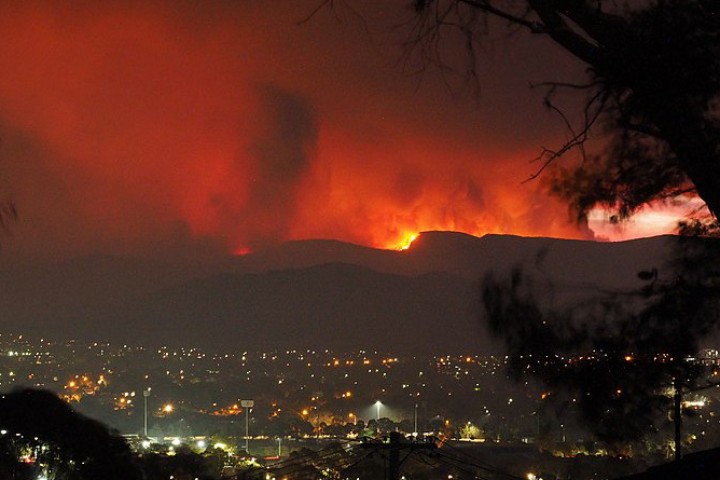How News About Climate And Environment Can Prompt And Enable Audience Action – OpEd

The Orroral Valley Fire viewed from Tuggeranong in southern Canberra, Australia. Photo Credit: Nick-D, Wikipedia Commons
Paradox: the period in which global public concern over climate change rose most steeply – roughly speaking, the five years after 2013 – also saw political parties elected to office in key carbon-emitting countries whose core purpose includes ignoring, denying or even defying the evidence on global heating while their members and clients carry on making money from extractive industries.
Exhibit A might be the UK, if only because it hosted the recent COP26 climate summit, in Glasgow. To listen to the hot air emanating from Prime Minister Boris Johnson would be to infer that Britain is ‘leading’ efforts to curb emissions. But this is the government that revoked an obligation on developers (long-term Conservative party donors) to ensure new-build homes are carbon-neutral, while approving a new coal mine in Cumbria and handing out licences to prospect for gas in the North Sea. Meanwhile, duty is still frozen on petrol, meaning the UK subsidises fossil fuels more than any other European country, according to OECD rules to which it has signed up, but which ministers disavow in rhetoric.
One could add a wearisomely familiar roll-call of similar offenders, including Donald Trump (elected 2016), who infamously claimed climate change was a hoax; Jair Bolsonaro, who green-lit the destruction of Brazil’s Amazon rainforest after taking office in early 2019, and India’s Narendra Modi, prime mover in a last-minute démarche to weaken the COP26 agreement on phasing out coal.
In many such instances, the ascendant parties or factions can rely on support from rural or regional electorates, away from big cities. That is certainly the case in Australia, where a Liberal/National Coalition ministry under Tony Abbott took office in 2013 and adopted, as its highest legislative priority, the aim of scrapping a carbon tax introduced by its Labor predecessor to deter excessive greenhouse gas emissions. The country has some of the highest emissions per capita, and its status as the world’s third-biggest exporter of coal makes it instrumentally responsible for a substantial share of other countries’ emissions as well.
Map Australia’s political preferences and the big splashes of Labor red are in state and territory capitals, along with inner Melbourne’s sole pinpoint of light Green. Hinterlands almost invariably tilt right, with many represented by the National Party component of the ruling Coalition (for the uninitiated: overwhelmingly white and male; tend to wear wide-brimmed Akubra hats while talking on camera; had to be dragged, reluctantly and at the last minute, to acquiesce in the cabinet’s COP26 commitment to net zero emissions by 2050).
Why should this be? There are, of course, familiar tropes of city-based know-alls telling country people their business. Such cultural divisions are – it will come as no surprise – a staple of analysis in right-wing media, many of which are controlled by Rupert Murdoch’s News Corporation. Anthony Klan, a rare whistle-blower from the flagship Australian newspaper, told an interviewer that NewsCorp journalism is “incredibly in the pocket of the lobbyists of the minerals, the mining, the gas and of the big banks”. Those who oppose the extractivist agenda, and the money behind it, are typically portrayed as members of a ‘latte-sipping metropolitan elite’.
But there are signs, in at least one part of rural Australia, that the tide may be turning. I use this (admittedly rather tired) metaphor because it concerns a pristine stretch of the New South Wales south coast. Look again at the political map from the last election, and one enclave stands out – that of Jervis Bay, an oblast of the Australian Capital Territory, along with the abutting federal division of Gilmore, the only seat Labor gained from the Coalition in 2019. (Interest declared: I am a Jervis Bay resident).
Even since then, the urgency of climate change, and of devising effective measures to limit it and reduce its effects, has been brought home anew. Again, the metaphor has a purpose. Indelibly ingrained on the Australian political psyche are pictures of householders standing on their rooftops, hosepipe in hand, preparing to douse flames from the catastrophic bushfire season of early 2020. Among the most memorable locally were those from Sussex Inlet, separated from the main bayside suburbs to the north only by a coastal basin – which may have saved them by halting the encroaching inferno, driven as it was by southerly winds, in its tracks.
“Urgency” is one of the key markers of effective news representations of climate change, put forward some years ago by the Communications Professor, Robert A Hackett. A brilliant scholar and writer, and a media activist in his native Canada on a range of interconnected issues of social and environmental justice, Bob became a guru of the global Peace Journalism movement.
In this, his equivalent model for environmental journalism, published in a special edition of Ethical Space in 2013, urgency must be linked with “agency” – making visible and accessible the interim steps from problem diagnosis to treatment recommendation. And, he argued, such connections are often best made on a local level:
Local frames could situate people within a greater social environment, implicating the community in its role in environmental degradation, the subsequent effects on its locality, and opportunities for change… Journalists could leverage the public awareness of local consequences towards the systematic and seemingly abstract processes of climate change (p 39).
Global heating is pushing the Australian climate further towards extremes – of wet, as well as hot and dry. The 2020 fires were rapidly followed by exceptional floods, which furnished equally resonant images of riverside houses being picked up and washed away. The immediate consequences, at least, are often most palpable in the ‘bush’ – traditional heartland of the political Right.
So will rural and regional Australia be convinced, as the Coalition government, now led by a slightly more voter-friendly Abbott-clone in Scott Morrison, approaches the next election with its ‘plan’ for net zero emissions by 2050? Outsourced to a management consultancy rather than produced by civil servants, the policy has been criticised for its avoidance of commitment to any specific action.
The same could be said of its cheerleaders in the Murdoch press, which professed a couple of months ago to have undergone a conversion from its previous denialist stance. A contribution to the Australian from “Wealth Editor James Kirby” drew attention to the opportunities for mineral extraction: “An increasingly desperate search for industrial strength alternatives to coal and oil in the lead up to the Glasgow COP26 climate conference is rapidly changing the outlook for uranium”. Never mind that there is no known safe way to dispose of the radioactive by-products of nuclear power: Australian miners wishing to make their contribution to the avoidance of catastrophe would simply be able to switch, it seemed, from mining – to mining.
Meanwhile, back in Jervis Bay, locals have detected something fishy in plans by the New South Wales government to expand tourism, with particular reference to coastal cruisers. Run by the Coalition since 2011, the state house, too, nestles snugly in the pocket of wealthy industrial and banking lobbies. Cruise ships are not allowed to enter the Bay without a permit from the local Marine Park management. But that has not stopped the area from appearing on itineraries advertised by cruise ship companies.
The story has been exposed and ventilated in two local media. The South Coast Register quoted a local activist from the Jervis Bay Community Cruise Ship Coalition, Penny Davidson: “We’re incredibly disappointed”, she told the paper, to see the plans still in place despite local opposition, and she went on to demand evidence of purported economic benefits to set against the impact on environmental values. “It’s the only marine park we have in the Shoalhaven and it’s of major importance we protect it in a pristine way”.
And the New Bush Telegraph expanded the frame of reference to look back on previous abortive plans to develop Jervis Bay, including a 1960s proposal for a nuclear power station. It also drew attention to the rich Aboriginal heritage of the area, which is well represented in Booderee National Park, run successfully (and sustainably) by the local Wreck Bay Community.
Both accounts exemplified Hackett’s call for journalism to ensure that environmentally friendly policy stances are “associated with cultural values of health and quality of life”. Do they portend a political shift, as cracks appear in what was previously an unshakeable alliance between rural electorates and business-aligned political actors?
The next test will come early next month, in elections to Shoalhaven City Council. Its directly elected Mayor is a Green, but a majority of seats are held by conservative groupings, albeit presenting themselves as ‘independent’. Some have been the target of voter anger over their perceived lack of action on the cruise ships issue.
Can the Greens (with possible support from Labor, presently stuck on just one seat) emerge as the largest party, even with a majority? Within its own confines, that would be a political earthquake; and an indication, perhaps, of wider relevance, in showing how changes of representation – in both senses – can be brought about.

